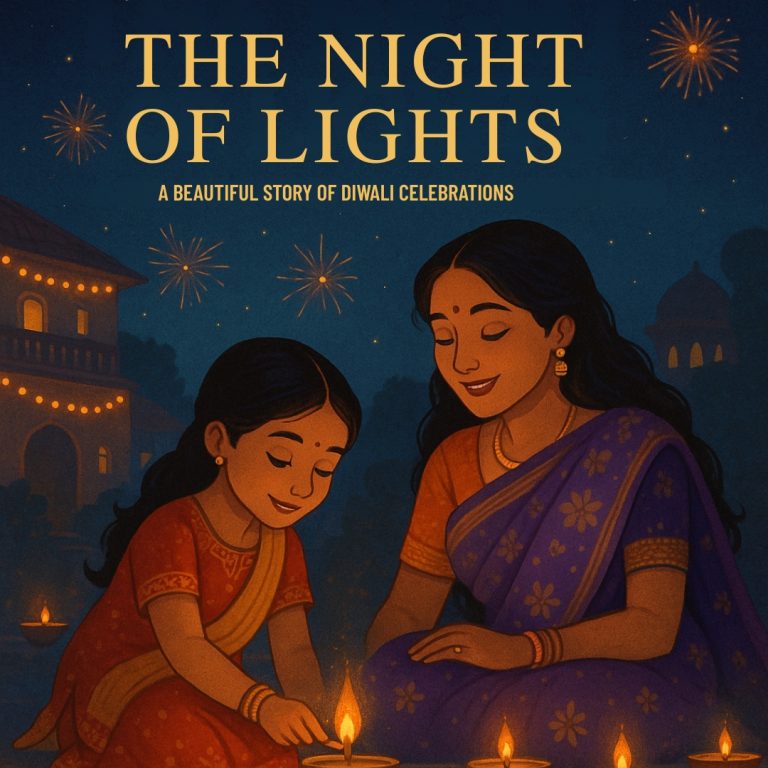
Anti-Aging Treatments in Banjara Hills, Jubilee Hills That Actually Work: Latest Trends in 2025 Aging is a natural process that...

Once upon a time, in a small town tucked away in the heart of India, lived a little girl named Vijaya. She woke up early one morning, rubbed the sleep from her eyes, and tiptoed to her window. The sky was still dusky, but faint glimmers of lamps were being lit across rooftops. It was Diwali, the festival of lights.
That morning, Vijaya’s mother handed her a tiny clay lamp (a diya) and whispered, “Tonight, when you light this lamp, you’ll join millions in whispering to the darkness: ‘You don’t belong here.’” Vijaya smiled, her heart dancing with anticipation.
As the sun set and the first stars appeared, Vijaya, dressed in a bright yellow kurta, joined her family in singing the Aarti (light-offering prayer). One by one, every home lit its lamps. The wicks flickered like stars brought down to earth. The darkness receded where light found space. Across streets and alleys, a soft golden glow spread, weaving stories of hope and togetherness.
That glowing night, Vijaya felt something shift inside; fear, sadness, and uncertainty all seemed quieter. She knew that Diwali Celebrations weren’t just about lights or sweets; it was about believing that within us lies the power to dispel darkness.
Diwali (also spelled Deepavali), often called the Festival of Lights, is one of India’s most beloved festivals. It typically falls in October or November, depending on the lunar calendar.
Diwali Celebrations celebrate the moment when light wins over darkness, good prevails over evil, and knowledge rises above ignorance.
Here’s a glimpse of the five-day festival commonly observed:
Day | Name | Significance |
| Day 1 | Dhanteras | Worship of wealth & prosperity; buying metals, utensils |
| Day 2 | Naraka Chaturdashi / Chhoti Diwali | Victory over the evil demon Narakasura |
| Day 3 | Lakshmi Puja (main Diwali day) | Invoke Goddess Lakshmi for prosperity |
| Day 4 | Govardhan Puja / Annakut | Worshipping Govardhan Hill, preparing food offerings |
| Day 5 | Bhai Dooj / Balipratipada | Celebrating brother-sister bond/return of King Bali |
Over the centuries, Diwali Celebrations have undergone significant evolution. In each region, unique customs, legends, and flavours take the spotlight. In many parts of North India, it is associated with the return of Lord Rama to Ayodhya after defeating Ravana, a moment when the entire kingdom was lit up with millions of lamps to welcome him home.
In West Bengal, Diwali is also tied to Kali Puja. In parts of South India, Deepavali is linked to Lord Krishna’s victory over Narakasura. The tales may differ, but the essence remains: light prevails.
Homes are cleaned, painted, and adorned. The idea is symbolic: remove the old to invite the new. The spaces we live in should sparkle just as our minds should.
Colourful patterns (rangoli) made with rice flour, flower petals, or colored powders decorate doorstep thresholds. Strings of fairy lights, lanterns (kandeel / akasha deepa) and earthen lamps line balconies and windows.
As dusk deepens, families light dozens of diyas. Each lamp is a prayer, a symbol, a statement: “In me is light, not darkness.”
Lakshmi Puja is performed with incense, flowers, sweets, and chants. Houses are opened doors and windows wide to invite prosperity and presence.
From gulab jamun to ladoos, kachoris to chaklis, kitchens buzz with the aroma of celebration. Every morsel carries warmth.
Though more mindful now about the environment and safety, many still light fireworks sparks climbing the skies like laughter.
Friends, neighbours, and family exchange sweets, gifts, and warm wishes. Diwali is also a time to give, especially to the less fortunate.
A festival’s true magic lives in stories. A child lighting a lamp, an elder sharing a myth, a community coming together, these are the threads that bind us.
Vijaya’s story is simple, but it’s universal: each of us has darkness inside, a fear, a regret, a sorrow and light is our daily ritual to chase it away. That’s what makes Diwali so powerful. Across the world, people celebrate it not only as a tradition, but as a metaphor, a reminder: no shadow is permanent if we bring even a spark of light.
As midnight approaches on Diwali’s main night, Vijaya gazes at the lamps outside. She realises each lamp is a story, each glow a promise. She whispers to herself: “Light first. Darkness after.” Because on this night, and in many nights ahead, the light within her will always have a voice.
At Twaccha, our wish for you is to carry that light forward in your stories, words, and actions. May your life be lit with hope, joy, and purpose. Let’s share these stories, connect across cultures, and let Diwali’s spirit shine far beyond one night.
Do you have a Diwali Celebrations memory or story? Share it in the comments below, let your light touch someone else’s darkness.

Anti-Aging Treatments in Banjara Hills, Jubilee Hills That Actually Work: Latest Trends in 2025 Aging is a natural process that...

Best Skin Specialist in Jubilee Hills, Banjara Hills – Your Skin’s True Care Starts at Twaccha Have you Remembered When...

Best Skin Clinic in Jubilee Hills, Hyderabad: Why Twaccha Stands Out If you’re searching for the best skin clinic in...
Diwali follows the Hindu lunar calendar. It falls on Amavasya (new moon night) of the Hindu month of Kartika, which corresponds to varying dates in October or November.
Lamps symbolise inner light, the power to dispel darkness, ignorance, and negativity. Lighting diyas is a symbolic act of inviting positivity and prosperity into one’s life.
Absolutely! Diwali’s themes, light, community, and hope, are universal. Many people of different faiths or cultural backgrounds join in with open hearts, learning, sharing, and celebrating.
No. Fireworks are a modern, celebratory addition. Many people now opt for eco-friendly celebrations using earthen lamps, LED lights, or silent sparklers to reduce noise and pollution.
Traditional gifts include sweets, dry fruits, sweets boxes, diyas, home décor items, candles, and gold or silver coins/utensils (especially on Dhanteras). In modern days, tech gadgets, gift cards, and plants are also popular.
Use rangoli at the entrance, clusters of diyas on windowsills, string lights over balconies, paper lanterns (kandeels), fresh flowers like marigolds, and scented candles indoors. Keep it clean, symmetrical, and meaningful.
Twaccha Skin Clinic specializes in skin and hair treatments. We offer services like acne treatment, anti-aging solutions, and skin rejuvenation. We focuses on using advanced techniques and personalized care to help clients achieve healthy, glowing skin. We also provide consultations to address individual skin concerns.